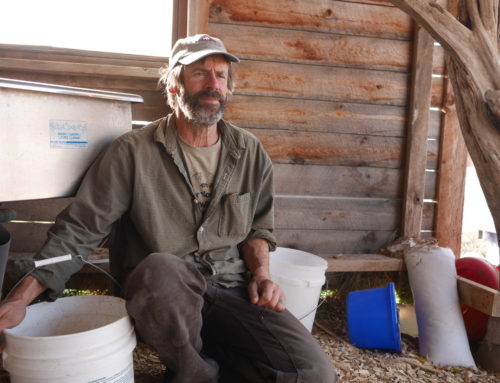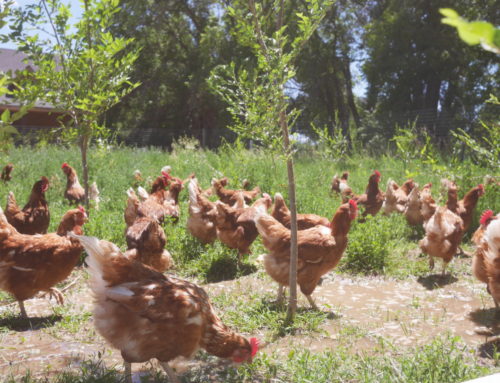Perched high above Paonia on Garvin Mesa, Oogie and Ken McGuire raise a flock of grass-fed Black Welsh Mountain sheep on the pasture beneath the family’s heritage apple orchard. Oogie grew up on the farm, where her mother raised sheep and other animals. She fell in love with shepherding when she decided to learn to spin and weave wool in order to make herself a traditional Medieval cloak. She not only ended up with a cloak, but also with a passion for the Black Welsh Mountain breed.

The Black Welsh Mountain breed originates from the hills of Britain. They are ideal for sustainable sheep production because they are good grazers and excellent mothers. They are also small in size and have a good temperament, which makes it easier for Ken and Oogie to manage the flock by themselves. Desert Weyr’s flock is especially sweet. “We breed for disposition,” Oogie says, “The mean ones become dinner.”
Unlike many sheep farmers around here, Oogie sells mostly mutton, not lamb. Even though the meat is of excellent quality, this can be an uphill battle. Mutton was once considered a prime meat, but after World War II, it fell out of favor in the U.S. Traumatized by gamey tinned rations made of tough, old sheep, soldiers returning from war swore off the stuff. This decimated the American sheep industry for decades. More than half a century later, lamb has made a comeback as a choice protein, but mutton still has a ways to go.
 Oogie is doing her best to change the perception of mutton being gamey, tough, or old. In fact, when it comes from sheep bred for mutton, the meat is tender and rich. Black Welsh Mountain sheep are particularly known as being superior for mutton. Like lamb, it has a distinct flavor, but it should never be strong or off-putting. Oogie uses the comparison of veal versus a well aged steak. Lamb, like veal, is from very young animals and has a delicate and sweet flavor. Mutton, on the other hand, is from a mature animal, making it’s meat richer and darker.
Oogie is doing her best to change the perception of mutton being gamey, tough, or old. In fact, when it comes from sheep bred for mutton, the meat is tender and rich. Black Welsh Mountain sheep are particularly known as being superior for mutton. Like lamb, it has a distinct flavor, but it should never be strong or off-putting. Oogie uses the comparison of veal versus a well aged steak. Lamb, like veal, is from very young animals and has a delicate and sweet flavor. Mutton, on the other hand, is from a mature animal, making it’s meat richer and darker.
I ask if there’s another word we can call it–a rebranding, so to speak, for this up and coming meat–but she says she’s bound by law to call it mutton. In the U.S., any sheep slaughtered after one year of age must be sold as mutton. So instead, she’s changing people’s views by raising top quality meat with excellent flavor and giving them a risk free way to give it a try: she offers a 100% satisfaction guarantee.
Tips for Cooking Mutton:
You can cook mutton just about the same as you would cook lamb. Most of the cuts will look the same, but be a bit larger than their lamb equivalent. Braise larger cuts like shoulder and leg roasts. Quickly sear steaks and chops. Classic flavors that pair well with mutton are rosemary, mint, garlic, and mustard seed. Or go the moroccan route with paprika, cumin, garlic, and cinnamon.
For a quick-cooking cut great for the grill, Oogie recommends trying the Pave steak. This uncommon cut comes from the hindquarter and is often lumped together with a leg roast. However, when it is separated out, it is both lean and tender.
Another cut we’re looking forward to trying is the breast. As Darina Allen, author of Forgotten Skills of Cooking (my favorite British cookbook) writes, the breast of lamb or mutton “is the sweet and delicious equivalent of pork belly, and is a very inexpensive cut of meat. Lean layers are interspersed with layers of fat, which renders out and gives the meat a sweet, succulent flavor.” Desert Weyr mutton breast comes rolled into a nice roast, so cooking is simple.
Try this easy recipe from Darina:
- 1 rolled breast of mutton from Desert Weyr
- 1 1/2 tablespoons coriander seeds
- 1 1/2 tablespoons sea salt
Preheat oven to 350 degrees. Roast the coriander seeds over medium heat for 3-4 minutes, until they begin to smell aromatic. Transfer to a mortar and pestle or spice grinder and grind into a coarse powder. Mix coriander with salt and spread out in a dish. Roll the roast around in the salt and coriander mixture so that it is coated on all sides. Place in a roasting pan or baking dish and roast until it reaches an internal temperature of 145 degrees (cooking times will depend on size, but start checking around 45 minutes to 1 hr).



![Farmers in Focus: Zimmerman Pork [and veggie] Farm](https://farmrunners.com/wp-content/uploads/2017/05/p1840797-e1679522915634-500x383.jpg)
